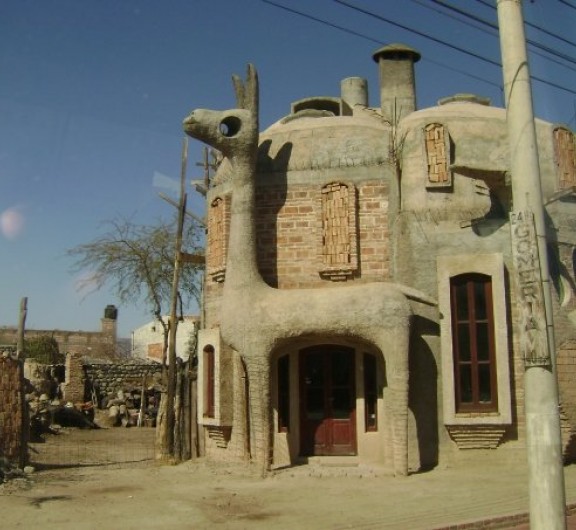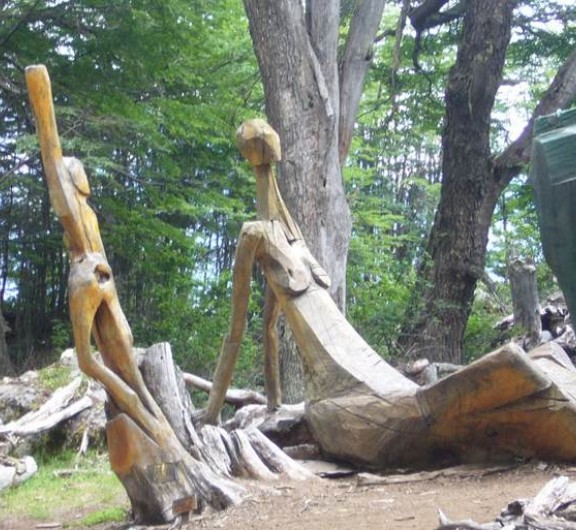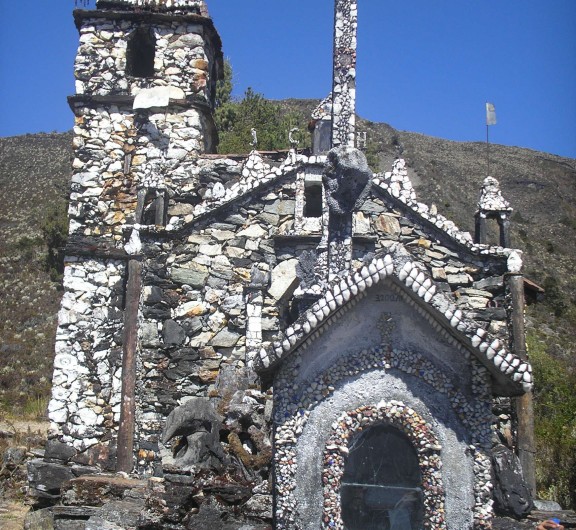La Casa de Botellas “La Fortaleza” [The Bottle House – The Fortress]Rubén “Tito” Ingenieri (b. ca. 1954)
About the Artist/Site
Ingenieri, a self-taught “art worker” (he doesn’t define himself as an artist), was born in Mataderos and did his military service in the Argentine Marines, despite his fear of water. Following his discharge, he worked at the Escuela Superior No. 4 “República de Japón” high school and made idiosyncratic artworks while taking the art of recycling to new levels. Although bottles are generally recyclable in Argentina, there are some that are not, and Ingenieri has made use of them in such a spectacular way that even the municipal government saves them for his use. His property, covered with some six million glass bottles, at his estimation, includes a small main house, a three-story “lighthouse” still under construction, a workshop and storage facility, and a series of perimeter walls that separate his property from that of his neighbors.
This project, which he began around 1992, is not his first unusual living arrangement: for some fifteen years he previously lived in a treehouse whose access stairs curled around the tree trunk. An inveterate collector and inventor, he says he is a náufrago del tiempo – a castaway from time – utilizing the physical castoffs of our post-industrial society to build his wonders. Except for the concrete mortar, all of the materials used in his constructions are recycled. This includes not only glass bottles of all sizes, shapes, and colors, but also found objects of metal, ceramics, stone, and more. In contrast to other bottle houses, which have tended to follow the standard formal parameters for building construction, Ingenieri’s structure includes walls protruding at geometric angles, their cantilevered surfaces emphasized by the necks of the bottles extending out from the exterior surfaces. The idiosyncrasy of the shape of the façade is primarily due to its metal armature, recycled steel that Ingenieri has welded into asymmetrical shapes, worked around and incorporating such found objects as port-hole windows and huge wagon wheels.
The house, enhanced with polished woodwork that was installed with the help of his friend Félix, a cabinet maker, extends up three stories, although a good percentage of the interior is still in progress. Nevertheless, the house has indoor plumbing and electricity – and even cable television. The interior, with low ceilings, is crowded with artwork and found objects of all kinds – paintings with sea themes, wet suits, a chandelier made from bottles, a curtain made from exposed film negatives, displays of his various collections, and much more. Ingenieri notes that the house also functions as a weather barometer, for when the southern winds blow in, creating a special identifiable sound, he knows that a storm will soon arrive and that the river, just a couple of blocks away, will soon begin to rise.
Quilmes, located around 10 miles south of Buenos Aires, is the name of the city where the compound is being constructed. It is, in addition, the home of Argentine’s national beer, also named Quilmes. Ingenieri’s neighborhood is modest, built of economical homes of cheap materials that are often flooded when the river overflows its banks; he dreams that the entire neighborhood will ultimately be renovated with all homes constructed with bottles. “That would change the history of Quilmes,” he exults, providing affordable shelter for the poor and the homeless for just the price of labor.
If the artist is at home, he is generally pleased to show visitors around the compound.
~Jo Farb Hernández, 2018
Contributors
Map & Site Information
760 De los Naranjos
Quilmes, Buenos Aires
ar
Latitude/Longitude: -34.7144338 / -58.2211938
Extant
760 De los Naranjos, Quilmes, Buenos Aires, Argentina
If the artist is at home, he is generally pleased to show visitors around the compound.
Nearby Environments







Post your comment
Comments
No one has commented on this page yet.